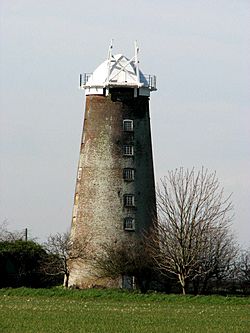Hickling Mill facts for kids
Quick facts for kids Hickling Windmill |
|
|---|---|

Hickling Mill
|
|
| Origin | |
| Coordinates | 52°45′3″N 1°34′3″E / 52.75083°N 1.56750°E |
| Operator(s) | Private |
| Year built | 1818 |
| Information | |
| Purpose | Corn mill |
| Type | Tower mill |
| Storeys | Eight storeys |
| No. of sails | Four sails |
| Winding | Fantail |
| Fantail blades | Eight blades |
| No. of pairs of millstones | Three pairs |
Hickling Mill is a very old and special windmill located in Hickling Heath, Norfolk, England. It was built in the 1800s and is considered a "Grade II* listed" building. This means it's an important historical site that needs to be protected.
Contents
Building a Windmill
Hickling Mill was built in 1818. It is a type of windmill called a tower mill. This means it has a round, tapering shape, wider at the bottom and narrower at the top. The mill is made of tarred brick.
How Tall is It?
The building has eight floors. The brick walls at the bottom are very thick, about 30 inches (76 cm) wide. Each floor has four windows. These windows face the four main directions: north, south, east, and west. Some windows are now blocked up inside the mill.
The Mill's Top
The very top of the mill is covered with weatherboard. This is a special type of wood covering. The top part looks like a boat and has a "petticoat" and a "fan cradle."
What the Mill Did
Hickling Mill was used as a corn mill. This means its main job was to grind wheat into flour. People would use this flour to bake bread and other foods.
From Grinding to Baking
By the 1860s, the mill also had a bakery. So, it not only made flour but also used it to bake goods. The mill stopped working in 1904. At that time, its large sails and the fantail were taken off.
Keeping History Alive
Over the years, Hickling Mill changed owners several times. In 1934, the Forbes family took over. They did a big repair job on the mill's top part in 1989.
A Special Kind of Preservation
Hickling Mill is quite unique. It is one of the few windmills in the country that has been kept mostly in its original state. This means it hasn't been fully rebuilt or changed much. It still has almost all of its main machinery inside. Many of the original wooden parts and three sets of millstones are also still there.
How the Mill Worked
The brick part of the tower is about 60 feet (18.2 meters) tall. The very top of the cap makes the total height about 71 feet (21.6 meters). The cap is shaped like a Norfolk boat. It used to have an eight-bladed fan and a gallery.
The Power of Wind
The mill had four large sails. Each sail had nine sections that could be opened or closed. A large wheel, about 9 feet (2.75 meters) across, helped control these sails. This wheel was called a brake wheel.
Inside the Mill
The sails powered three pairs of "French burr stones." These were special millstones used for grinding. The mill could also run two flour mills, a cylinder, and a "jumper." It could even power three "dressing machines" and an "oat crusher." These machines helped process the grain and make different types of flour or animal feed.

